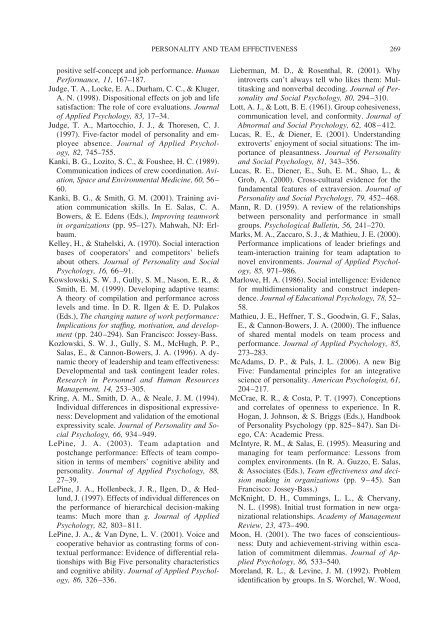What makes a good team player? Personality and team effectiveness
What makes a good team player? Personality and team effectiveness
What makes a good team player? Personality and team effectiveness
- No tags were found...
You also want an ePaper? Increase the reach of your titles
YUMPU automatically turns print PDFs into web optimized ePapers that Google loves.
PERSONALITY AND TEAM EFFECTIVENESS269positive self-concept <strong>and</strong> job performance. HumanPerformance, 11, 167–187.Judge, T. A., Locke, E. A., Durham, C. C., & Kluger,A. N. (1998). Dispositional effects on job <strong>and</strong> lifesatisfaction: The role of core evaluations. Journalof Applied Psychology, 83, 17–34.Judge, T. A., Martocchio, J. J., & Thoresen, C. J.(1997). Five-factor model of personality <strong>and</strong> employeeabsence. Journal of Applied Psychology,82, 745–755.Kanki, B. G., Lozito, S. C., & Foushee, H. C. (1989).Communication indices of crew coordination. Aviation,Space <strong>and</strong> Environmental Medicine, 60, 56–60.Kanki, B. G., & Smith, G. M. (2001). Training aviationcommunication skills. In E. Salas, C. A.Bowers, & E. Edens (Eds.), Improving <strong>team</strong>workin organizations (pp. 95–127). Mahwah, NJ: Erlbaum.Kelley, H., & Stahelski, A. (1970). Social interactionbases of cooperators’ <strong>and</strong> competitors’ beliefsabout others. Journal of <strong>Personality</strong> <strong>and</strong> SocialPsychology, 16, 66–91.Kowslowski, S. W. J., Gully, S. M., Nason, E. R., &Smith, E. M. (1999). Developing adaptive <strong>team</strong>s:A theory of compilation <strong>and</strong> performance acrosslevels <strong>and</strong> time. In D. R. Ilgen & E. D. Pulakos(Eds.), The changing nature of work performance:Implications for staffing, motivation, <strong>and</strong> development(pp. 240–294). San Francisco: Jossey-Bass.Kozlowski, S. W. J., Gully, S. M., McHugh, P. P.,Salas, E., & Cannon-Bowers, J. A. (1996). A dynamictheory of leadership <strong>and</strong> <strong>team</strong> <strong>effectiveness</strong>:Developmental <strong>and</strong> task contingent leader roles.Research in Personnel <strong>and</strong> Human ResourcesManagement, 14, 253–305.Kring, A. M., Smith, D. A., & Neale, J. M. (1994).Individual differences in dispositional expressiveness:Development <strong>and</strong> validation of the emotionalexpressivity scale. Journal of <strong>Personality</strong> <strong>and</strong> SocialPsychology, 66, 934–949.LePine, J. A. (2003). Team adaptation <strong>and</strong>postchange performance: Effects of <strong>team</strong> compositionin terms of members’ cognitive ability <strong>and</strong>personality. Journal of Applied Psychology, 88,27–39.LePine, J. A., Hollenbeck, J. R., Ilgen, D., & Hedlund,J. (1997). Effects of individual differences onthe performance of hierarchical decision-making<strong>team</strong>s: Much more than g. Journal of AppliedPsychology, 82, 803–811.LePine, J. A., & Van Dyne, L. V. (2001). Voice <strong>and</strong>cooperative behavior as contrasting forms of contextualperformance: Evidence of differential relationshipswith Big Five personality characteristics<strong>and</strong> cognitive ability. Journal of Applied Psychology,86, 326–336.Lieberman, M. D., & Rosenthal, R. (2001). Whyintroverts can’t always tell who likes them: Multitasking<strong>and</strong> nonverbal decoding. Journal of <strong>Personality</strong><strong>and</strong> Social Psychology, 80, 294–310.Lott, A. J., & Lott, B. E. (1961). Group cohesiveness,communication level, <strong>and</strong> conformity. Journal ofAbnormal <strong>and</strong> Social Psychology, 62, 408–412.Lucas, R. E., & Diener, E. (2001). Underst<strong>and</strong>ingextroverts’ enjoyment of social situations: The importanceof pleasantness. Journal of <strong>Personality</strong><strong>and</strong> Social Psychology, 81, 343–356.Lucas, R. E., Diener, E., Suh, E. M., Shao, L., &Grob, A. (2000). Cross-cultural evidence for thefundamental features of extraversion. Journal of<strong>Personality</strong> <strong>and</strong> Social Psychology, 79, 452–468.Mann, R. D. (1959). A review of the relationshipsbetween personality <strong>and</strong> performance in smallgroups. Psychological Bulletin, 56, 241–270.Marks, M. A., Zaccaro, S. J., & Mathieu, J. E. (2000).Performance implications of leader briefings <strong>and</strong><strong>team</strong>-interaction training for <strong>team</strong> adaptation tonovel environments. Journal of Applied Psychology,85, 971–986.Marlowe, H. A. (1986). Social intelligence: Evidencefor multidimensionality <strong>and</strong> construct independence.Journal of Educational Psychology, 78, 52–58.Mathieu, J. E., Heffner, T. S., Goodwin, G. F., Salas,E., & Cannon-Bowers, J. A. (2000). The influenceof shared mental models on <strong>team</strong> process <strong>and</strong>performance. Journal of Applied Psychology, 85,273–283.McAdams, D. P., & Pals, J. L. (2006). A new BigFive: Fundamental principles for an integrativescience of personality. American Psychologist, 61,204–217.McCrae, R. R., & Costa, P. T. (1997). Conceptions<strong>and</strong> correlates of openness to experience. In R.Hogan, J. Johnson, & S. Briggs (Eds.), H<strong>and</strong>bookof <strong>Personality</strong> Psychology (pp. 825–847). San Diego,CA: Academic Press.McIntyre, R. M., & Salas, E. (1995). Measuring <strong>and</strong>managing for <strong>team</strong> performance: Lessons fromcomplex environments. (In R. A. Guzzo, E. Salas,& Associates (Eds.), Team <strong>effectiveness</strong> <strong>and</strong> decisionmaking in organizations (pp. 9–45). SanFrancisco: Jossey-Bass.)McKnight, D. H., Cummings, L. L., & Chervany,N. L. (1998). Initial trust formation in new organizationalrelationships. Academy of ManagementReview, 23, 473–490.Moon, H. (2001). The two faces of conscientiousness:Duty <strong>and</strong> achievement-striving within escalationof commitment dilemmas. Journal of AppliedPsychology, 86, 533–540.Morel<strong>and</strong>, R. L., & Levine, J. M. (1992). Problemidentification by groups. In S. Worchel, W. Wood,










